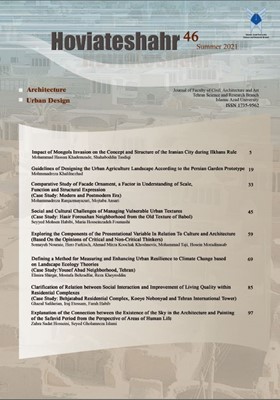Social and cultural challenges of managing vulnerable urban textures (Case study: Hasir Foroushan neighborhood from the old texture of Babol)
Subject Areas : urban planningSeyyed Mohsen Habibi 1 , Maria Hosseinzadeh Foumashi 2
1 - Professor of Urban planning Faculty at Collage of Fine Arts, University of Tehran, Tehran, Iran.
2 - M.A. in Urban Planning, Collage of Fine Arts, University of Tehran, Tehran, Iran
Keywords: Vulnerable texture, Managing Vulnerability, Babol, Urban texture,
Abstract :
Cities as the biological context of human societies, like other living beings, experience obsolescence, a key factor of the vulnerability of cities over time; and this phenomenon is natural and inevitable. Therefore, vulnerability is an inevitable phenomenon occurring in all urban textures; and leads to social, economic and physical decline in the urban context; and in total, decline in urban life. In Iran, vulnerability is occurring in cities with much more speed and intensity; and therefore, in recent decades, considering vulnerable urban textures by preparing management projects and plans has been carried out. But less attention to social and cultural dimensions is an obstacle to the fulfillment of these plans. As a result, vulnerability continues to appear in urban textures. Therefore, addressing the social and cultural challenges of managing vulnerable urban textures, is crucial; because managing vulnerability, to high extent, depends on the will and demand of the local community. Thus, this study aims to identify and analyze the social and cultural challenges in managing vulnerable urban textures. In order to achieve this goal, Hasir Foroushan neighborhood from the old and vulnerable texture of the city of Babol is chosen as the case study; and the qualitative research method is used to produce grounded theory. Grounded theory, is a theory that is extracted directly from data gathered during the study and analyzed on a regular basis. The key point is that collecting and analyzing data must be done simultaneously. With the help of open and in-depth interview technique with 24 members of the neighborhood, whom are chosen on purpose; the useful data has been gathered, coded and analyzed. Then, according to the research method which is The Grounded Theory; seven main categories and twelve sub-categories are obtained. These categories and sub categories are: “Community engagement, Values according to the old texture (including two sub-categories titled as: Moral, social and cultural values dependent on the old texture of neighborhood; and Valuable lifestyle of people living in old textures) , demographic features of the local community (including two sub-categories titled as: Impacts of aging population living in the neighborhood; and Impacts of the dominant presence of men in the neighborhood) , local community’s perception , social class conditions, costs and benefits of managing vulnerability (including two sub-categories titled as Low profits from spending for reparation of old textures; and Difficulties of repairing old textures) , and the local communities distrust of urban planning and management organizations, management plans, regulations, and practices (including three sub-categories titled as: Distrust of institutions involved in management of old textures, Uncertainty of management projects and regulations and rules, and Negative attitudes against renovation of old textures) ”; are identified as the social and cultural challenges of managing the vulnerability of the neighborhood. The results of this study, help forming the theory arising from gathered data. This theory which is comprehensive and abstract, is titled as: “The key role of social construction and cultural background in the willingness and action of the local community in managing vulnerability of the neighborhood”.
اخوان خرازی، کامیار. (۱۳۸۷). رویکردی تحلیلی بهضرورت توجه به فرهنگ جوامع. هویت شهر، 2(۳)، ۵۱-6۱.
استراوس، انسلم؛ و کربین، جولیت. (۱۳۹۲). مبانی پژوهش کیفی، فنون و مراحل تولید نظریه زمینهای. (ابراهیم افشار، مترجم). تهران: نشر نی، چاپ سوم. (نشر اثر اصلی 1998 ).
گروتر، یورک. (۱۳۷۵). زیباشناختی در معماری. (جهانشاه پاکزاد و عبدالرضا همایون، مترجمان). تهران: دانشگاه شهید بهشتی. (نشر اثر اصلی 1987 ).
مهندسان مشاور زیستا. (۱۳۸۵). طرح بهسازی بافت قدیم بابل. تهران: پدیدآورنده.
مهندسان مشاور نقش پیراوش. (۱۳۷۹). طرح تفصیلی ویژه بافت فرسوده بابل. تهران: پدیدآورنده.
مهندسان مشاور هفت شهر آریا. (۱۳۸۹). طرح بهسازی و نوسازی بافت فرسوده بابل. تهران: سازمان عمران و بهسازی شهری ایران.
Charmaz, C. (2000). Grounded Theory: Objective and Subjective Methods, Handbook of Qualitive Research. New York: Sage.
Creswell, J. W. (2005). Educational research: Planning, Conducting and Evaluating Quantative and Qualitive Research. (2nd ed.). New York: Pearson Education.
Fernandez, W. (2004). Using the Glaserian Approach in Grounded Theory Studies of Emerging Business Practices. Electronic Journal of Business Research Methods, 2, 83-94.
Glaser, B. G., & Strauss, A. L. (1967). The Discovery of Grounded Theory: The Strategies for Qualitive Research. New Jersey: Aldine Transaction.
Pandit, N. R. (1996). The Creation of Theory: A recent Application of the Grounded Theory Method. The Qualitive Report, 2(4), 1-15.
_||_

